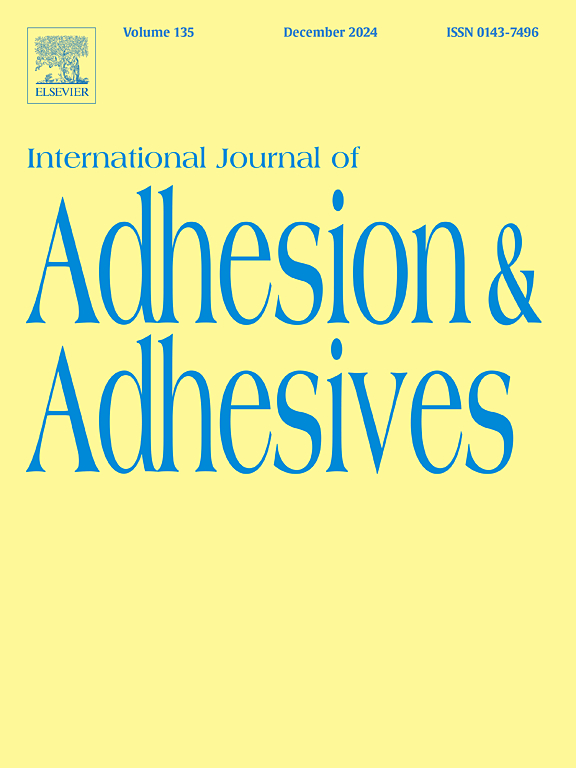Acid-base properties of polydimethylsiloxane based adhesives and their influence on adhesion to polymer surfaces
IF 3.5
3区 材料科学
Q2 ENGINEERING, CHEMICAL
International Journal of Adhesion and Adhesives
Pub Date : 2025-04-05
DOI:10.1016/j.ijadhadh.2025.104028
引用次数: 0
Abstract
This work aimed to investigate the adhesive properties of polysiloxanes (silicones) on polymer surfaces in relation to their acid-base properties. To adjust the acid-base properties of polydimethylsiloxane (PDMS) based formulations, (3-aminopropyl)-trimethoxysilane (AMMO) and [(3-triethoxysilyl)-propyl]succinic anhydride (SAS) were added as silane coupling agents. The acid-base properties of the resulting formulations were investigated by measuring the isoelectric point (IEP) via zeta potential measurements as well as by measuring the contact angle on cured samples with probe liquids of different pH. The IEP could be increased gradually from 5.7 to 9.3 by addition of AMMO and decreased gradually from 5.7 to 2.7 by addition of SAS. The adhesion to various polymers was determined by tensile lap shear strength measurements on HDPE, PET, PMMA, PVC and PA as well as on glass. Silicones containing AMMO showed a higher shear strength on all polymers compared to the acidic SAS containing silicones. The IEP leading to maximum shear strength depends on the respective polymer surface, which makes the adjustment of the acid-base properties a useful tool for optimizing adhesion. Furthermore, measuring the zeta potential as well as the surface energy of the substrate surfaces revealed significant differences in their polarity. In addition, an approximately linear increase of the maximum shear strength measured on each substrate could be observed with increasing zeta potential of the substrate at pH 9.7. These findings show that zeta potential measurements of both adhesive and substrate have the potential to be a powerful tool for predicting adhesive interactions.

聚二甲基硅氧烷基胶粘剂的酸碱性质及其对聚合物表面粘附力的影响
本工作旨在研究聚硅氧烷(有机硅)在聚合物表面的粘附性能与其酸碱性质的关系。为了调整聚二甲基硅氧烷(PDMS)为基础的配方的酸碱性质,加入(3-氨基丙基)-三甲氧基硅烷(AMMO)和[(3-三乙氧基硅基)-丙基]丁二酸酐(SAS)作为硅烷偶联剂。通过zeta电位测量等电点(IEP)和不同ph的探针液对固化样品的接触角的测量,研究了配方的酸碱性质。添加AMMO可使IEP从5.7逐渐升高到9.3,添加SAS可使IEP从5.7逐渐降低到2.7。通过对HDPE、PET、PMMA、PVC和PA以及玻璃的拉伸搭接剪切强度测量来确定与各种聚合物的粘附性。含AMMO的有机硅比含酸性SAS的有机硅在所有聚合物上表现出更高的剪切强度。导致最大剪切强度的IEP取决于各自的聚合物表面,这使得酸碱性质的调整成为优化粘附性的有用工具。此外,测量zeta电位以及衬底表面的表面能揭示了它们的极性有显著差异。此外,在pH为9.7时,随着基材zeta电位的增加,可以观察到每种基材上测得的最大抗剪强度近似线性增加。这些发现表明,胶粘剂和基材的zeta电位测量有可能成为预测胶粘剂相互作用的有力工具。
本文章由计算机程序翻译,如有差异,请以英文原文为准。
求助全文
约1分钟内获得全文
求助全文
来源期刊

International Journal of Adhesion and Adhesives
工程技术-材料科学:综合
CiteScore
6.90
自引率
8.80%
发文量
200
审稿时长
8.3 months
期刊介绍:
The International Journal of Adhesion and Adhesives draws together the many aspects of the science and technology of adhesive materials, from fundamental research and development work to industrial applications. Subject areas covered include: interfacial interactions, surface chemistry, methods of testing, accumulation of test data on physical and mechanical properties, environmental effects, new adhesive materials, sealants, design of bonded joints, and manufacturing technology.
 求助内容:
求助内容: 应助结果提醒方式:
应助结果提醒方式:


